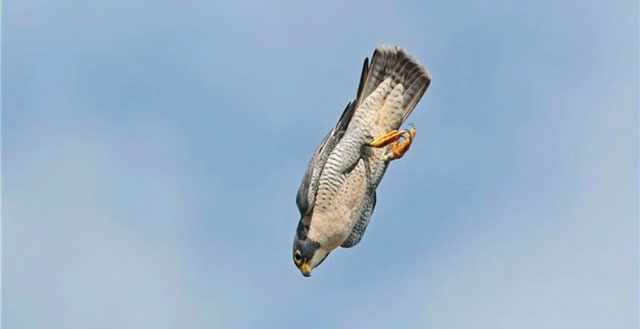A steppe kestrel kills a mallard with a 'shadowless' dive at a speed of 90km/h
After just a few seconds, the duck was completely unconscious, and the 'culprit' appeared. It was a steppe kestrel, although it was not yet mature.
Analyzing the video, scientists discovered that the kestrel with a dive of up to 90km/h hit the target, causing the mallard to completely not understand what was going on and was killed.
The video was recorded on the outskirts of Calgary - the southern city of Alberta province, Canada, where large flocks of wild ducks gather to feed. This also attracts many birds of prey to the "duck buffet".
It is known that when encountering waterfowl foraging in the fields, steppe kestrels often use this method of launching a direct "punch" to minimize the animal's ability to resist.

The prairie kestrel (Falco mexicanus) is a species of bird in the genus Falconidae.
The steppe kestrel has a long wingspan, but is thin and pointed. This body structure allows performing dives from the air at very high speeds.
This bird species is distributed in western North America, in harsh desert environments with low prey densities. Therefore, in order to survive, this bird has evolved into an extremely dangerous predator, able to hunt both mammals and large birds.
Steppe kestrels often fly very high, with exceptionally good eyesight they can observe their prey easily. When 'locking on the target', the bird quickly flies down and gradually increases speed, performing dives with speeds of up to 100 km/h.
Kestrels often attack the head or eyeballs of their prey. Extremely fast speed combined with sharp claws, after a collision with a falcon, the prey will often be stunned and unconscious. Then, the steppe kestrel will approach its prey, using its claws and beaked beak with a sharp tip to enjoy the meal.
You should read it
- The 15 most dangerous roads on the planet make you 'sweaty'
- 10 incredible facts about languages - how animals communicate
- Life Paul Allen, who dragged Bill Gates away from Harvard, founded Microsoft
- Discover 2,600-year-old theater walls in Turkey
- 8 differences of successful people in the world
- Using application notes To write on Windows 10
 To their surprise, the elephants also called each other by name
To their surprise, the elephants also called each other by name Which animal can hold its breath the longest?
Which animal can hold its breath the longest? It is not recommended to take seashells from the beach and why
It is not recommended to take seashells from the beach and why Strange dog with bear face, cat teeth, fox mouth
Strange dog with bear face, cat teeth, fox mouth The cave of death kills any creature that enters
The cave of death kills any creature that enters The most dangerous fish in the world, with the largest venom gland of any other fish
The most dangerous fish in the world, with the largest venom gland of any other fish